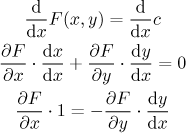Theorem (Implicit function theorem).
Consider an equation
![]()
then there exists a neighborhood U of x0 and a
function
Moreover, this function is differentiable at x0 and

We start with some theory which is a bit beyond what we know so far (at least officially, namely we need to use functions of more variables), then we will look at practical approach.
Consider an equation
Theorem (Implicit function theorem).
Consider an equationF(x,y) = c. Let a point(x0,y0) satisfy this equation. If
then there exists a neighborhood U of x0 and a function
y = y(x) on this neighborhood such thaty(x0) = y0 andF(x,y(x)) = c for all x from U.Moreover, this function is differentiable at x0 and
We used the Leibniz notation, since it makes clear with respect to which variable we differentiate. Nice as this rule is, we usually do not use it literally; rather, we repeat the procedure by which we obtain it.
The proof of this rule is quite simple. We take the original equation

From the last equality we get the formula in the theorem. The trick of differentiating the equation and then solving for the derivative of y is called implicit differentiation and it is the easiest way to get the derivative of an implicit function.
Example: In Implicit functions in Functions - Theory we proved that
the equation
Solution: To get the tangent line we need a point - which we have -
and its slope, namely we need y′ at
[(y(x))3 + 1]′ = [x⋅y(x)]′
3(y(x))2⋅[y(x)]′ = [x]′⋅y(x) + x⋅[y(x)]′
3(y(x))2⋅y′(x) = y(x) + x⋅y′(x)
We obtained an equation that features
3(y(2))2⋅y′(2) = y(2) + 2y′(2).
How much is
3⋅12⋅y′(2) = 1 + 2y′(2).
From this we get
y = 1⋅(x − 2) + 1, y = x − 1.
Remark: An experienced student could save some writing by not putting
the
3y2y′ = y + xy′.
Instead of substituting
![]()
This expression can be used to find derivative at all points from the
neighborhood where this
If we differentiate the equation that we obtained once more, we get the second derivative.
[3y2y′]′ = [y + xy′]′
[3y2]′y′ + 3y2[y′]′ = [y]′ + [x]′y′ + x[y′]′
6yy′y′ + 3y2y′′ = y′ + y′ + xy′′
6y(y′)2 + 3y2y′′
= 2y′ + xy′′
From this we get
![]()
Similarly we can find higher order derivatives.
For a review and an example of implicit differentiation see Implicit differentiation in Methods Survey.
Derivative of parametric functions
Back to Theory - Implicit and
parametric functions